Pollution Removal Performance of Laboratory Simulations of Sydney’s Street Stormwater Biofilters
Abstract
1. Introduction
2. Materials and Methods
2.1. Soil Columns
2.2. Synthetic Stormwater
2.3. Column Performance Experimental Method
- 1.
- Purging: To limit background column “noise”, naturally occurring soluble ions were purged from the soil column using deionised-water flushing until the three-day median for electrical conductivity (EC), a proxy for ion content, fell to 5% of that of the synthetic stormwater. This typically took eight consecutive days for a fill that is compliant with City of Sydney biofilter material specifications, as discussed later. Post-purge draining for 16 h resulted in a median mass reduction of 70% reducing the risk of potential dilution of pollutants in the synthetic stormwater.
- 2.
- Dosing: Each primary column was dosed with 1.1 L of synthetic stormwater per hour based on the unsaturated hydraulic conductivity rate for the soil column, as determined by a Decagon Devices® mini disk portable tension infiltrometer. For each experimental run, dosing was maintained for three hours based on the dosing regime established elsewhere for effective cation capture [25,32], which complied with recorded median rainfall duration for the years 2010 to 2013 [33]. It must be noted that the dosing cycle was based principally on hydraulic and not climatological considerations given the endemically high rainfall variability on the Eastern seaboard relating to the El Nino Southern Oscillation, reducing the reliability of rainfall prediction since the year 2000 [34].
- 3.
- Sample removal: A representative aliquot of the water drained from each column during each 19 h event was bottled for transport and analysis in compliance with Standard Methods [39]. In terms of quality control, no significant difference was noted in the level of individual pollutants taken at different stages of the sampling cycle (with the exception of copper), although a risk of dilution of “new” water with “old” water (such as purge) remaining in the biphasic columns has been reported in the literature [40]. Initial high copper release may, however, have been an artefact resulting from the leaching of nutrients and metals from organic material in the columns, offsetting the dilution of pollutants by residual purge water in initial column runs. The amount of water that was retained in the saturation sump wasshown to be <0.64 L by experimentation; offering potentially low dilution.
2.4. Laboratory Analysis, Data Capture and Statistical Analysis
3. Results and Discussion
3.1. Nutrient Removal: Total Nitrogen (TN) and Total Phosphorus (TP)
3.2. Heavy Metal Removal
3.2.1. Dissolved-Phase Heavy Metals
3.2.2. Suspended- or Settled-Phase Heavy Metals
3.3. Total Suspended Solids (SS) Release
4. Conclusions
Acknowledgments
Author Contributions
Conflicts of Interest
References
- Todeschini, S. Hydrologic and environmental impacts of imperviousness in an industrial catchment of northern Italy. J. Hydrol. Eng. 2016, 21, 05016013. [Google Scholar] [CrossRef]
- Yuan, Q.; Guerra, H.B.; Kim, Y. An investigation of the relationships between rainfall conditions and pollutant wash-off from the paved road. Water 2017, 9, 232. [Google Scholar] [CrossRef]
- Al Ali, S.; Debade, X.; Chebbo, G.; Béchet, B.; Bonhomme, C. Contribution of atmospheric dry deposition to stormwater loads for PAHs and trace metals in a small and highly trafficked urban road catchment. Environ. Sci. Pollut. Res. 2017, 1–16. [Google Scholar] [CrossRef] [PubMed]
- Spooner, D.R.; Maher, W.A.; Otway, N. Trace metal concentrations in sediments and oysters of Botany Bay, NSW, Australia. Arch. Environ. Contam. Toxicol. 2003, 45, 92–101. [Google Scholar] [CrossRef] [PubMed]
- Birch, G.F.; Cruickshank, B.; Davis, B. Modelling nutrient loads to Sydney estuary (Australia). Environ. Monit. Assess. 2010, 167, 333–348. [Google Scholar] [CrossRef] [PubMed]
- Nath, B.; Chaudhuri, P.; Birch, G. Assessment of biotic response to heavy metal contamination in Avicennia marina mangrove ecosystems in Sydney Estuary, Australia. Ecotoxicol. Environ. Saf. 2014, 107, 284–290. [Google Scholar] [CrossRef] [PubMed]
- City of Sydney Council. Decentralised Water Master Plan 2012–2030; City of Sydney Council: Sydney, Australia, 2012.
- Derry, C.; Macnamara, J.W.; Davis, K. A Performance Monitoring Framework for Raingardens as Decentralised Stormwater Treatment Systems in the City of Sydney; University of Western Sydney: Richmond, Australia, 2013. [Google Scholar]
- Zinger, Y.; Blecken, G.-T.; Fletcher, T.D.; Viklander, M.; Deletić, A. Optimising nitrogen removal in existing stormwater biofilters: Benefits and tradeoffs of a retrofitted saturated zone. Ecol. Eng. 2013, 51, 75–82. [Google Scholar] [CrossRef]
- Maltby, L.; Forrow, D.M.; Boxall, A.; Calow, P.; Betton, C.I. The effects of motorway runoff on freshwater ecosystems: 1. Field study. Environ. Toxicol. Chem. 1995, 14, 1079–1092. [Google Scholar] [CrossRef]
- Gillis, P.L. Cumulative impacts of urban runoff and municipal wastewater effluents on wild freshwater mussels (lasmigona costata). Sci. Total Environ. 2012, 431, 348–356. [Google Scholar] [CrossRef] [PubMed]
- Zhang, J.; Hua, P.; Krebs, P. Influences of land use and antecedent dry-weather period on pollution level and ecological risk of heavy metals in road-deposited sediment. Environ. Pollut. 2017, 228, 158–168. [Google Scholar] [CrossRef] [PubMed]
- Lau, S.-L.; Han, Y.; Kang, J.-H.; Kayhanian, M.; Stenstrom, M.K. Characteristics of highway stormwater runoff in los angeles: Metals and polycyclic aromatic hydrocarbons. Water Environ. Res. 2009, 81, 308–318. [Google Scholar] [CrossRef] [PubMed]
- Markiewicz, A.; Björklund, K.; Eriksson, E.; Kalmykova, Y.; Strömvall, A.-M.; Siopi, A. Emissions of organic pollutants from traffic and roads: Priority pollutants selection and substance flow analysis. Sci. Total Environ. 2017, 580, 1162–1174. [Google Scholar] [CrossRef] [PubMed]
- Gunawardana, C.; Goonetilleke, A.; Egodawatta, P.; Dawes, L.; Kokot, S. Role of solids in heavy metals buildup on urban road surfaces. J. Environ. Eng. 2012, 138, 490–498. [Google Scholar] [CrossRef]
- Liu, X.M.; Li, H.; Li, R.; Tian, R.; Hou, J. A new model for cation exchange equilibrium considering the electrostatic field of charged particles. J. Soils Sediments 2012, 12, 1019–1029. [Google Scholar] [CrossRef]
- Cameron, K.C.; Harrison, D.F.; Smith, N.P.; McLay, D.A. A method to prevent edge-flow in undisturbed soil cores and lysimeters. Aust. J. Soil Res. 1990, 28, 879–886. [Google Scholar] [CrossRef]
- Brown, R.A.; Hunt, W.F. Impacts of media depth on effluent water quality and hydrologic performance of undersized bioretention cells. J. Irrig. Drain. Eng. 2011, 137, 132–143. [Google Scholar] [CrossRef]
- Corwin, D.L. Evaluation of a simple lysimeter-design modification to minimize sidewall flow. J. Contam. Hydrol. 2000, 42, 35–49. [Google Scholar] [CrossRef]
- Lewis, J.; Sjöstrom, J. Optimizing the experimental design of soil columns in saturated and unsaturated transport experiments. J. Contam. Hydrol. 2010, 115, 1–13. [Google Scholar] [CrossRef] [PubMed]
- Gude, V.G.; Truax, D.D.; Magbanua, B.S. Natural treatment and onsite processes. Water Environ. Res. 2013, 85, 1232–1261. [Google Scholar] [CrossRef]
- Read, J.; Fletcher, T.D.; Wevill, T.; Deletic, A. Plant traits that enhance pollutant removal from stormwater in biofiltration systems. Int. J. Phytoremediat. 2010, 12, 34–53. [Google Scholar] [CrossRef]
- Virahsawmy, H.K.; Stewardson, M.J.; Vietz, G.; Fletcher, T.D. Factors that affect the hydraulic performance of raingardens: Implications for design and maintenance. Water Sci. Technol. 2014, 69, 982–988. [Google Scholar] [CrossRef] [PubMed]
- Hurst, C.J.; Crawford, R.L.; Garland, J.L.; Lipson, D.A. Manual of Environmental Microbiology, 3rd ed.; American Society for Microbiology Press: Washington, DC, USA, 2007. [Google Scholar]
- Yang, H.; McCoy, E.L.; Grewal, P.S.; Dick, W.A. Dissolved nutrients and atrazine removal by column-scale monophasic and biphasic rain garden model systems. Chemosphere 2010, 80, 929–934. [Google Scholar] [CrossRef] [PubMed]
- Read, J.; Wevill, T.; Fletcher, T.; Deletic, A. Variation among plant species in pollutant removal from stormwater in biofiltration systems. Water Res. 2008, 42, 893–902. [Google Scholar] [CrossRef] [PubMed]
- Wan, Z.; Li, T.; Shi, Z. A layered bioretention system for inhibiting nitrate and organic matters leaching. Ecol. Eng. 2017, 107, 233–238. [Google Scholar] [CrossRef]
- Davis, A.P.; Shokouhian, M.; Sharma, H.; Minami, C. Water quality improvement through bioretention media: Nitrogen and phosphorus removal. Water Environ. Res. 2006, 78, 284–293. [Google Scholar] [CrossRef] [PubMed]
- Sun, X.; Davis, P. Heavy metal fates in laboratory bioretention systems. Chemosphere 2007, 66, 1601–1609. [Google Scholar] [CrossRef] [PubMed]
- Henderson, C.; Greenway, M.; Phillips, I. Removal of dissolved nitrogen, phosphorus and carbon from stormwater by biofiltration mesocosms. Water Sci. Technol. 2007, 55, 183–191. [Google Scholar] [CrossRef] [PubMed]
- Davis, A.P.; Shokouhian, M.; Minami, C.; Winogradoff, D. Water quality improvement through bioretention: Lead, copper, and zinc removal. Water Environ. Res. 2003, 75, 73–82. [Google Scholar] [CrossRef] [PubMed]
- Birch, G.F.; Fazeli, M.S.; Matthai, C. Efficiency of an infliltration basin in removing contaminants from urban stormwater. Environ. Monit. Assess. 2005, 101, 23–38. [Google Scholar] [PubMed]
- Bureau of Meteorology. Daily Rainfall Data for Observatory Hill, Sydney Town, Period 3 February 2010 to 29 January 2013; Bureau of Meteorology: Melbourne, Australia, 2015.
- Attwater, R.; Anderson, L.; Derry, C. Agricultural risk management of a peri-urban water recycling scheme to meet mixed land-use needs. Agric. Water Manag. 2016, 176, 266–269. [Google Scholar] [CrossRef]
- Rusciano, G.M.; Obropta, C.C. Bioretention Column Study: Fecal Coliform and Total Suspended Solids Reductions. Am. Soc. Agric. Biol. Eng. 2007, 50, 1261–1269. [Google Scholar] [CrossRef]
- Davis, A.P.; Shokouhian, M.; Sharma, H.; Minami, C. Laboratory study of biological retention for urban stormwater management. Water Environ. Res. 2001, 73, 5–14. [Google Scholar] [CrossRef] [PubMed]
- Vanderlinden, K.; Giráldez, J.V. Field Water Capacity. In Encyclo of Agrophys; Gliński, J., Horabik, J., Lipiec, J., Eds.; Springer: Dordrecht, The Netherlands, 2011. [Google Scholar]
- Pelissari, C.; Guivernau, M.; Viñas, M.; de Souza, S.S.; Sezerino, P.H.; Ávila, C.; García, J. Unraveling the active microbial populations involved in nitrogen utilization in a vertical subsurface flow constructed wetland treating urban wastewater. Sci. Total Environ. 2017, 584–585, 642–650. [Google Scholar] [CrossRef] [PubMed]
- American Public Health Association; American Water Works Association; Water Environment Federation. Standard Methods for the Examination of Water and Wastewater; American Public Health Association: Washington, DC, USA, 2005; Volume 2. [Google Scholar]
- Payne, E.G.I.; Pham, T.; Cook, P.L.M.; Fletcher, T.D.; Hatt, B.E.; Deletic, A. Biofilter design for effective nitrogen removal from stormwater—Influence of plant species, inflow hydrology and use of a saturated zone. Water Sci. Technol. 2014, 69, 1312–1319. [Google Scholar] [CrossRef] [PubMed]
- Björklund, K.; Li, L. Removal of organic contaminants in bioretention medium amended with activated carbon from sewage sludge. Environ. Sci. Pollut. Res. 2017, 24, 19167–19180. [Google Scholar] [CrossRef] [PubMed]
- Stouthamer, A.H.; de Boer, A.P.N.; van der Oost, J.; van Spanning, R.J.M. Emerging principles of inorganic nitrogen metabolism in paracoccus denitrificans and related bacteria. Anton. Leeuwenhoek 1997, 71, 33–41. [Google Scholar] [CrossRef]
- Ergas, S.; Sengupta, S.; Siegel, R.; Pandot, A.; Yao, Y.; Yuan, X. Performance of nitrogen-removing bioretention systems for control of agricultural runoff. J. Environ. Eng. 2010, 136, 1105–1112. [Google Scholar] [CrossRef]
- Riffat, R. Fundamentals of Wastewater Treatment and Engineering; International Water Association CRC Press: London, UK, 2012. [Google Scholar]
- Hsieh, C.-H.; Davis, A.P.; Needelman, B.A. Bioretention column studies of phosphorus removal from urban stormwater runoff. Water Environ. Res. 2007, 79, 177–184. [Google Scholar] [CrossRef] [PubMed]
- Le Fevre, G.H.; Paus, K.H.; Natarajan, P.; Gulliver, J.S.; Novak, P.J.; Hozalski, R.M. Review of dissolved pollutants in urban storm water and their removal and fate in bioretention cells. J. Environ. Eng. 2015, 141, 04014050. [Google Scholar] [CrossRef]
- Huber, M.; Welker, A.; Helmreich, B. Critical review of heavy metal pollution of traffic area runoff: Occurrence, influencing factors, and partitioning. Sci. Total Environ. 2016, 541, 895–919. [Google Scholar] [CrossRef] [PubMed]
- Westerlund, C.; Viklander, M. Particles and associated metals in road runoff during snowmelt and rainfall. Sci. Total Environ. 2006, 362, 143–156. [Google Scholar] [CrossRef] [PubMed]
- Bennasir, H.; Sridhar, S. Health hazards due to heavy metal poisoning and other factors in sea foods. Int. J. Pharm. Sci. Rev. Res. 2013, 18, 33–37. [Google Scholar]
- Hrubá, F.; Strömberg, U.; Černá, M.; Chen, C.; Harari, F.; Harari, R.; Horvat, M.; Koppová, K.; Kos, A.; Krsková, A.; et al. Blood cadmium, mercury, and lead in children: An international comparison of cities in six european countries, and china, ecuador, and morocco. Environ. Int. 2012, 41, 29–34. [Google Scholar] [CrossRef] [PubMed]
- Kayhanian, M.; Stransky, C.; Bay, S.; Lau, S.L.; Stenstrom, M.K. Toxicity of urban highway runoff with respect to storm duration. Sci. Total Environ. 2008, 389, 386–406. [Google Scholar] [CrossRef] [PubMed]
- Klaassen, C.D. Casarett and Doull’s Toxicology: The Basic Science of Poisons; McGraw-Hill: New York, NY, USA, 2013; Volume 1236. [Google Scholar]
- Li, H.; Davis, A.P. Water quality improvement through reductions of pollutant loads using bioretention. J. Environ. Eng. 2009, 135, 567–576. [Google Scholar] [CrossRef]
- Hatt, B.E.; Fletcher, T.D.; Deletic, A. Hydrologic and pollutant removal performance of stormwater biofiltration systems at the field scale. J. Hydrol. 2009, 365, 310–321. [Google Scholar] [CrossRef]
- Ross, S.M. Toxic Metals in Soil-Plant Systems; John Wiley and Sons Ltd.: Hoboken, NJ, USA, 1994. [Google Scholar]
- Hatt, B.E.; Fletcher, T.D.; Deletic, A. Hydraulic and pollutant removal performance of fine media stormwater filtration systems. Environ. Sci. Technol. 2008, 42, 2535–2541. [Google Scholar] [CrossRef] [PubMed]
- Gunawardena, J.; Ziyath, A.M.; Egodawatta, P.; Ayoko, G.A.; Goonetilleke, A. Sources and transport pathways of common heavy metals to urban road surfaces. Ecol. Eng. 2015, 77, 98–102. [Google Scholar] [CrossRef]
- Australian and New Zealand Environment and Conservation Council; Agriculture and Resource Management Council of Australia and New Zealand. Australian and New Zealand Guidelines for Fresh and Marine Water Quality, Canberra; Australian and New Zealand Environment and Conservation Council: Canberra, Australia, 2000.
- Davis, A.P. Field performance of bioretention: Water quality. Environ. Eng. Sci. 2007, 24, 1048–1064. [Google Scholar] [CrossRef]
- Subramaniam, D.N.; Egodawatta, P.; Mather, P.; Rajapakse, J. Stabilization of stormwater biofilters: Impacts of wetting and drying phases and the addition of organic matter to filter media. Environ. Manag. 2015, 56, 630–642. [Google Scholar] [CrossRef] [PubMed]
- Facility for Advancing Water Biofiltration. Guidelines for Filter Media in Biofiltration Systems (Version 3.01); Facility for Advancing Water Biofiltration: Melbourne, Australia, 2009; p. 8. [Google Scholar]
- Duong, T.T.T.; Penfold, C.; Marschner, P. Differential effects of composts on properties of soils with different textures. Biol. Fertil. Soils 2012, 48, 699–707. [Google Scholar] [CrossRef]
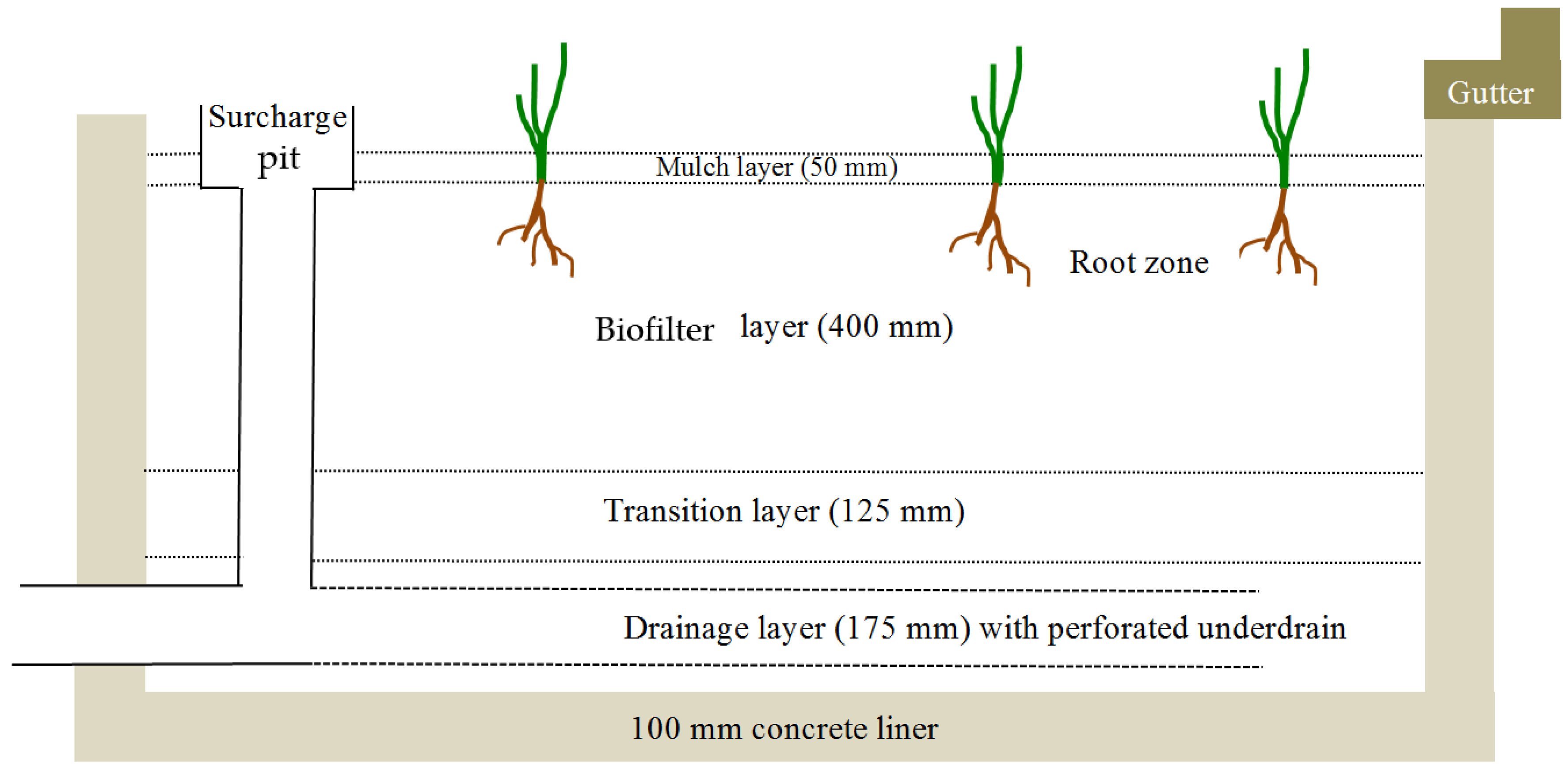
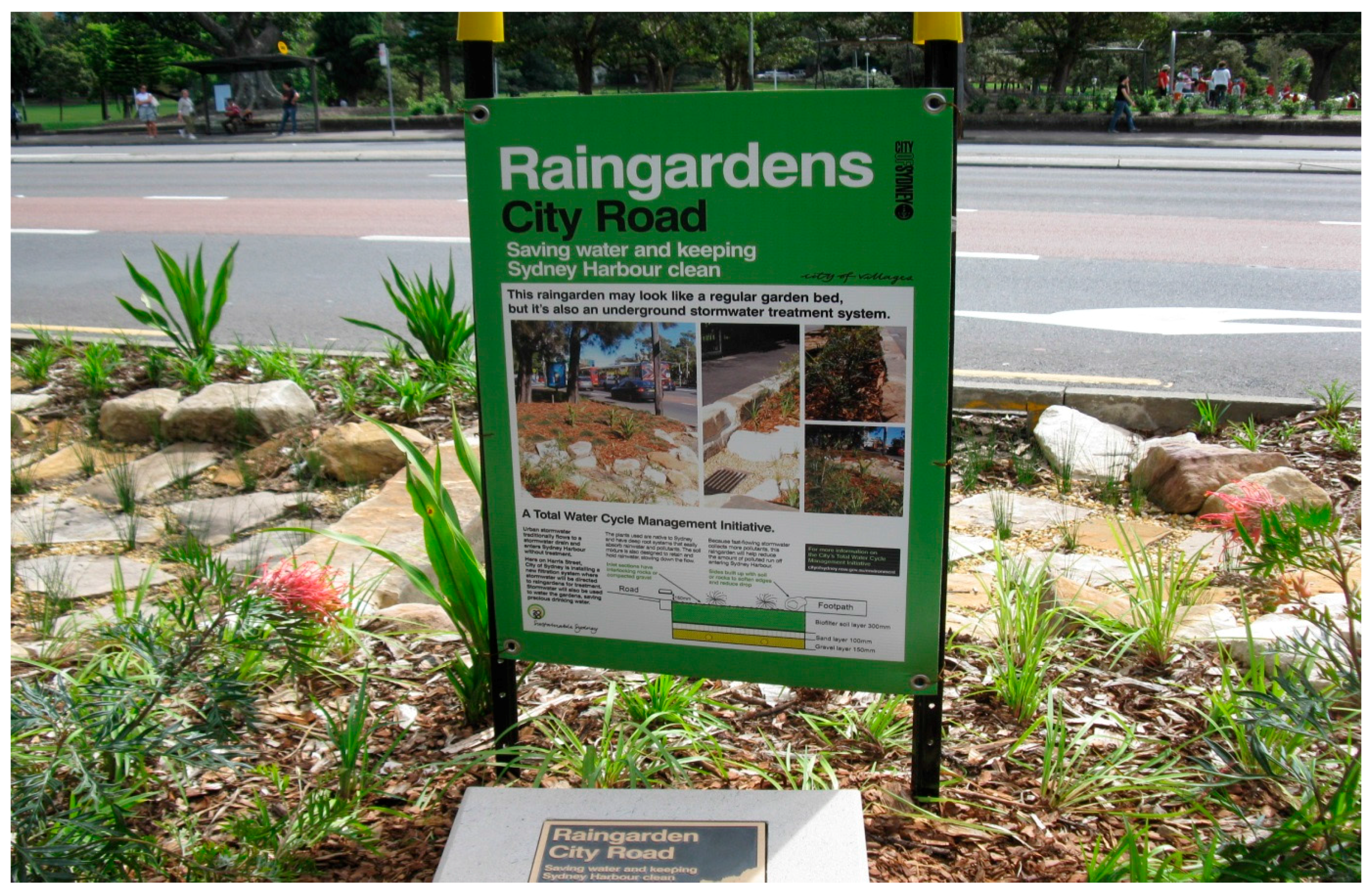
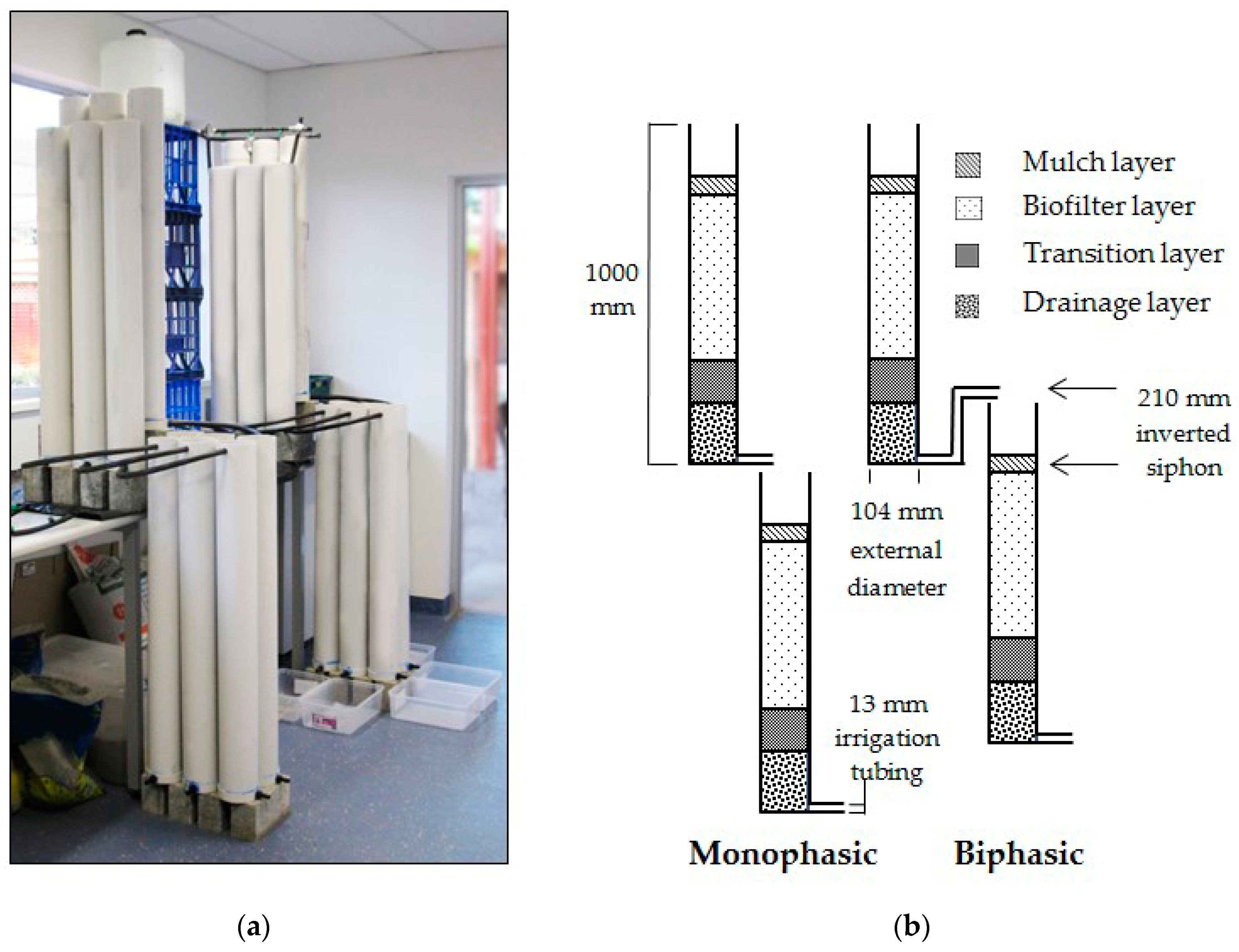
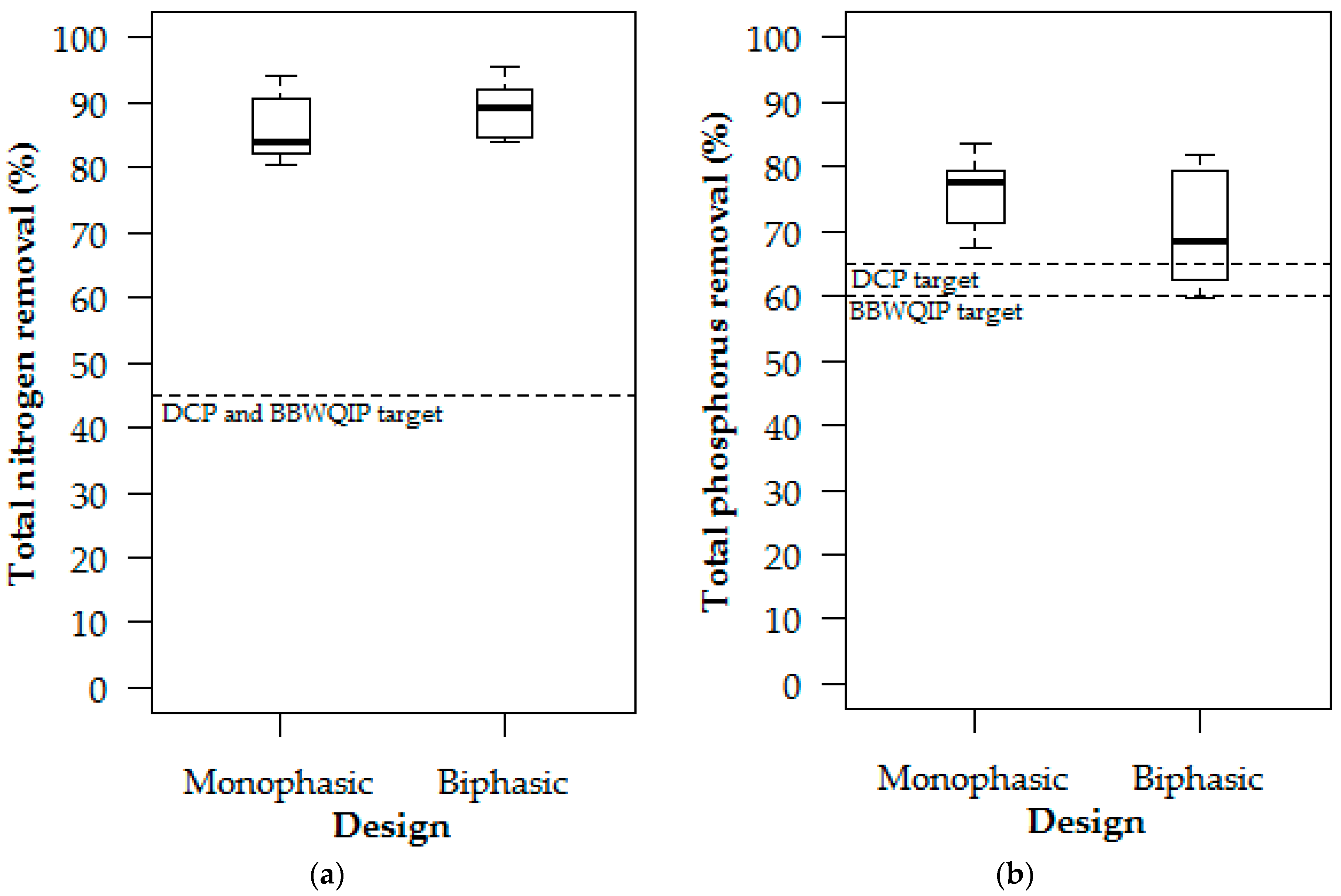
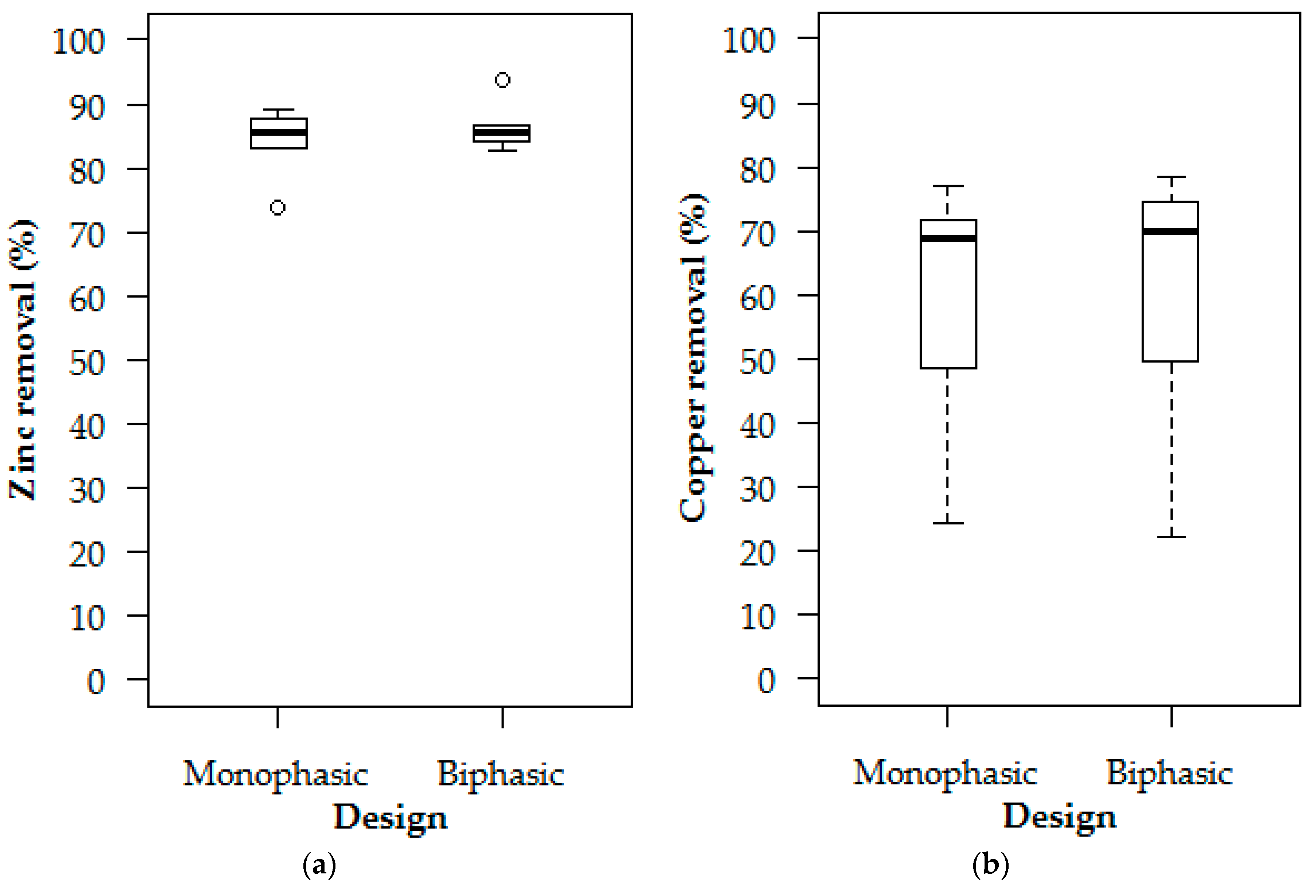

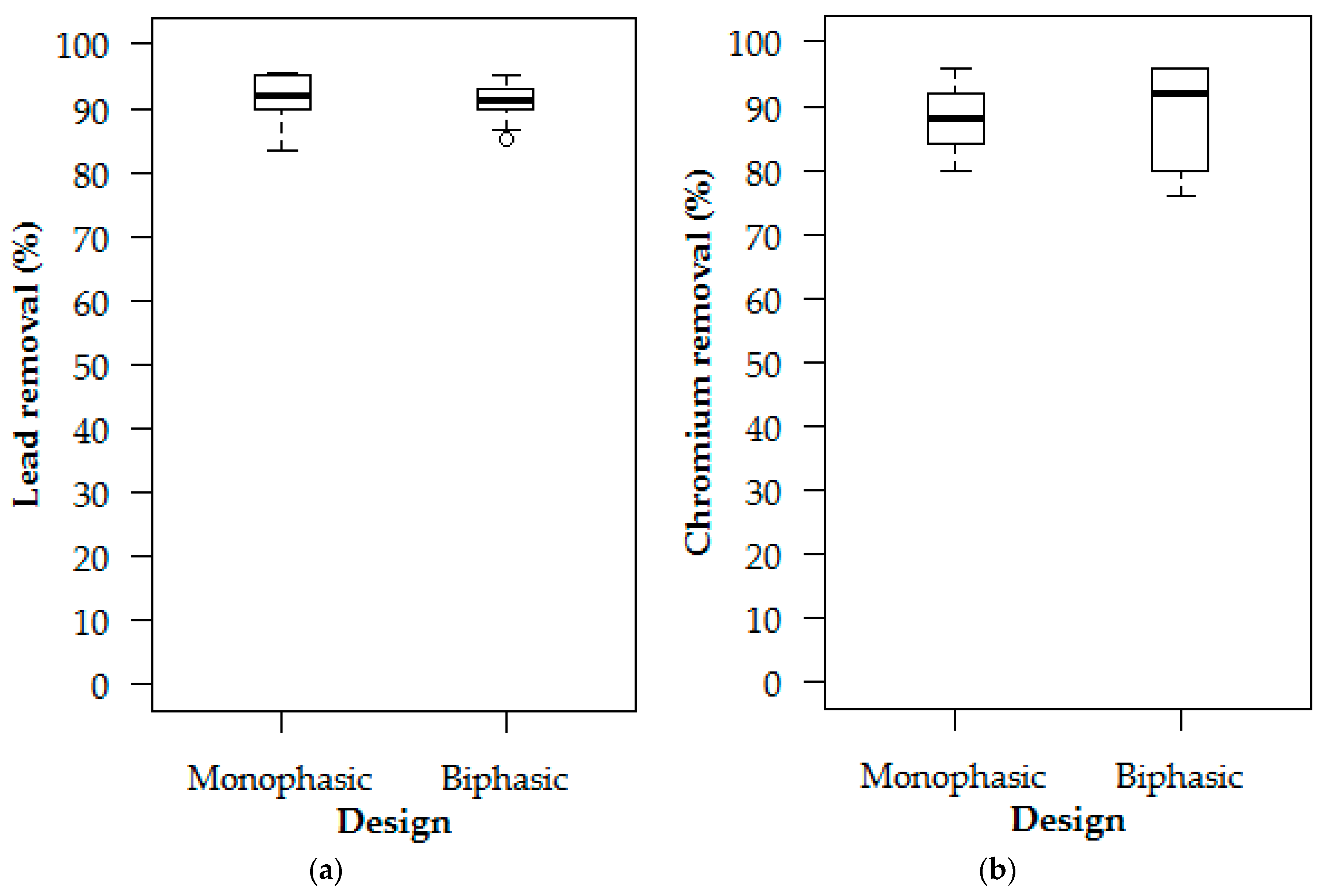
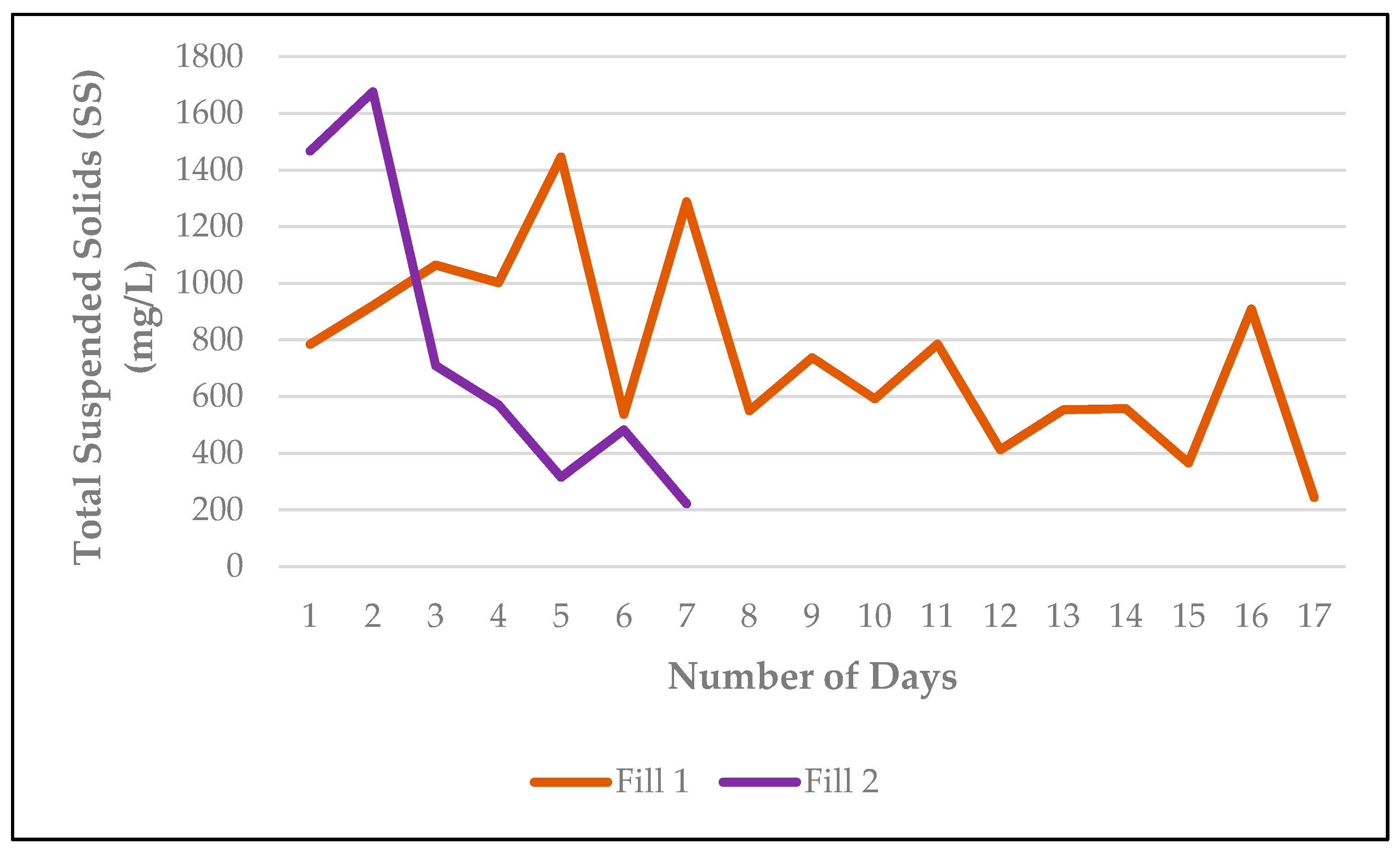
| Water Quality Parameter | Development Control Plan (DCP) Removal Target | Botany Bay Water Quality Improvement Plan (BBWQIP) Removal Target |
|---|---|---|
| Total Nitrogen (TN) | 45% | 45% |
| Total Phosphorus (TP) | 65% | 60% |
| Total Suspended Solids (SS) | 85% | 80% |
| Gross Pollutants | 90% (>5 mm) | 90% (>5 mm) |
| Pollutant Parameter | Source Compounds in Synthetic Stormwater | Pollutant Concentrationin Synthetic Stormwater (mg/L) | Pollutant Concentration (Median) after Biofiltration (mg/L) | Removal Efficiency (Median) for Biofiltration Simulation (%) | ||
|---|---|---|---|---|---|---|
| Mono-Phasic | Bi-Phasic | Mono-Phasic | Bi-Phasic | |||
| TN | Ammonium, nickel and lead nitrates | 16.19 | 2.58 | 1.78 | 84.1 | 89.0 |
| TP | Trisodium phosphate | 10.00 | 2.22 | 3.15 | 77.8 | 68.5 |
| Zn | Zinc chloride | 0.690 | 0.098 | 0.103 | 85.8 | 85.1 |
| Cu | Copper sulphate | 0.140 | 0.044 | 0.042 | 68.6 | 70.0 |
| Ni | Nickel nitrate | 0.070 | 0.006 | 0.008 | 91.4 | 88.6 |
| Cd | Cadmium chloride | 0.013 | 0.0004 | 0.0003 | 96.9 | 97.7 |
| Pb | Lead nitrate | 0.300 | 0.024 | 0.025 | 92.0 | 91.8 |
| Cr | Potassium chromate | 0.050 | 0.006 | 0.004 | 88.0 | 92.0 |
| Biofilter Layer and Liner | Specification (Based on FAWB Guidelines [61]) |
|---|---|
| Mulch | Washed aggregate, 10 mm to 20 mm grade |
| Filtration | Sandy loam mix, with saturate hydraulic conductivity > 100 mm/h to 300 mm/h. Total clay and silt content < 3%. Organic content < 5% |
| Transitional | Washed, recycled glass-sand, or coarse washed river sand with little or no fines |
| Drainage | No-fines drainage gravel, 2 mm to 5 mm grade |
| Outer liner | Concrete |
© 2017 by the authors. Licensee MDPI, Basel, Switzerland. This article is an open access article distributed under the terms and conditions of the Creative Commons Attribution (CC BY) license (http://creativecommons.org/licenses/by/4.0/).
Share and Cite
Macnamara, J.; Derry, C. Pollution Removal Performance of Laboratory Simulations of Sydney’s Street Stormwater Biofilters. Water 2017, 9, 907. https://doi.org/10.3390/w9110907
Macnamara J, Derry C. Pollution Removal Performance of Laboratory Simulations of Sydney’s Street Stormwater Biofilters. Water. 2017; 9(11):907. https://doi.org/10.3390/w9110907
Chicago/Turabian StyleMacnamara, James, and Chris Derry. 2017. "Pollution Removal Performance of Laboratory Simulations of Sydney’s Street Stormwater Biofilters" Water 9, no. 11: 907. https://doi.org/10.3390/w9110907
APA StyleMacnamara, J., & Derry, C. (2017). Pollution Removal Performance of Laboratory Simulations of Sydney’s Street Stormwater Biofilters. Water, 9(11), 907. https://doi.org/10.3390/w9110907





